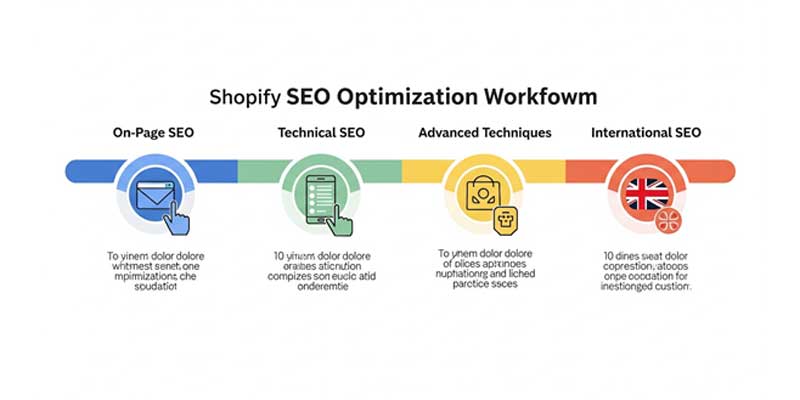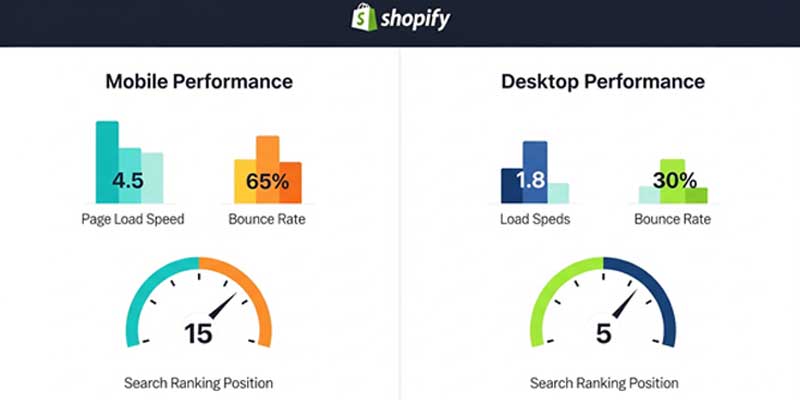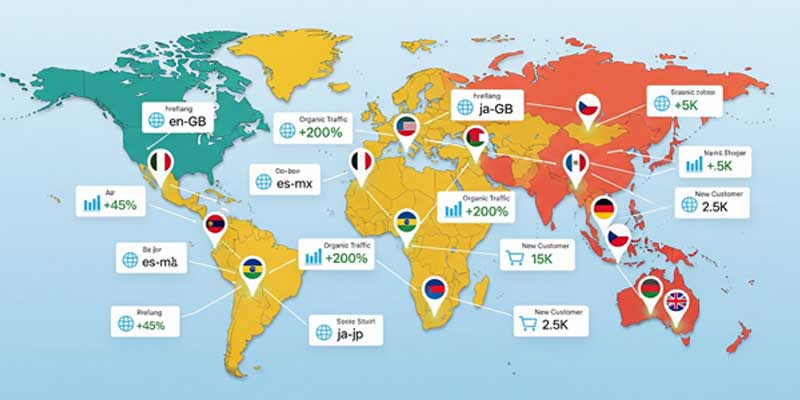

Effective Shopify SEO mastery remains essential in modern e-commerce since it drives natural traffic and boosts store sales. More companies establishing their presence online requires businesses to utilize effective Shopify SEO tips because they need to stand out in search results to capture potential customers. The following section outlines ten compelling methods that improve Shopify rankings.
When managing a Shopify store, several common SEO mistakes can hinder your search rankings. Duplicate content caused by multiple product URLs without proper canonical tags confuses search engines. Poorly written meta titles and descriptions miss opportunities to boost visibility, while unoptimized images slow down loading times and lack descriptive alt text. Neglecting mobile optimization results in poor user experience and higher bounce rates. Complex or long URLs reduce clarity and SEO effectiveness. Additionally, skipping internal linking prevents key pages from gaining ranking power, and failing to submit an XML sitemap delays indexing by Google. Many also overlook adding structured data, which helps search engines display rich snippets in search results. Avoiding these mistakes by applying best practices ensures your Shopify store ranks higher, attracts more organic traffic, and provides a better user experience.
Shopify SEO refers to the process of optimizing a Shopify store to improve its visibility in search engine results pages (SERPs). It involves a combination of strategies and techniques focused on enhancing both on-page and technical aspects of the store. Unlike traditional websites, Shopify stores have specific structures, default themes, and built-in features that require tailored optimization practices. From optimizing product pages, meta titles, and descriptions to improving site speed and mobile responsiveness, Shopify SEO ensures that the store ranks higher, attracts organic traffic, and drives sales. It is a continuous process that involves regular monitoring, analysis, and updates as search engine algorithms evolve.
Search engines like Google use automated programs called crawlers to scan and index web pages, including Shopify stores. These crawlers follow links from one page to another, reading content, metadata, images, and structured data to understand the relevance and quality of each page. In Shopify, the default sitemap.xml file helps search engines find all pages of a store, but factors such as duplicate content, poorly structured URLs, slow page speed, and missing metadata can hinder efficient indexing. Proper use of canonical tags prevents search engines from indexing duplicate content, while clean URL structures make it easier for crawlers to understand the hierarchy of products and collections. Additionally, implementing structured data markup (Schema) enables search engines to display rich results such as product ratings and pricing, improving click-through rates.

Website organization stands as a base requirement for successful Shopify site speed optimization and enhances user engagement. A well-organized hierarchy structure enables search engine understanding while it improves customer product discovery. Plan your site structure with basic collections that link between related products while maintaining every product accessible within a maximum of three clicks starting from the homepage. You should use URLs that describe your items while including key phrases and enable both users and search spiders to follow your site structure through breadcrumb navigation features. Partnering with a Shopify website development company can further streamline this process, ensuring an optimized structure that enhances both SEO and user experience.
Successful Shopify SEO starts with thorough keyword research. You should target keywords with multiple words that indicate buying behavior while maintaining reasonable market competition. Natural inclusion of target keywords should become part of your Shopify product title structure and descriptive text alongside meta content and alternative image text. The practice of excessive keyword placement should be avoided since it can lead to deteriorated Shopify rankings. Author professional and informative content that answers customer inquiries by seamlessly integrating appropriate search terms.
The Shopify site speed optimization plays an essential role in achieving better SEO performance and improving conversion rates. A slow page loading time has two negative effects on Shopify rankings and overall user experience. Before photo uploads to your store, you should compress all pictures and activate Shopify's lazy loading functionality. To minimize site speed issues you need to delete unneeded apps from your site. You should also use Google PageSpeed Insights to track your store's performance at regular intervals. High site speed benefits your Shopify SEO performance and at the same time decreases visitor exit rates while driving more sales.
Creating original product descriptions with complete detail stands among the best advice for improving Shopify SEO performance. Develop original descriptions that identify customer problems and show distinct selling characteristics instead of using manufacturer-made content. Naturally, integrate relevant keywords into your texts when emphasizing product advantages instead of concentrating on specifications. The detailed descriptions offer both better Shopify search engine visibility and practical shopping information for possible consumers.

The basis for how your store performs in search engines stems from Technical SEO elements. Every page of your site must contain exclusive title tags while each meta description incorporates useful keywords. To improve search results fix all broken links in addition to implementing canonical tags for duplicate content solutions alongside an XML sitemap creation. The technical optimizations of your Shopify store through SEO work to enhance search engine understanding of your content for proper indexing.
The success of Shopify SEO depends entirely on producing first-class content. The creation of a blog platform allows you to publish valuable industry guidance, product advice, and useful tips that focus on your target business sector. Your valuable content will prove your expertise while identifying relevant search terms and allow you to establish internal linking through useful connections. Your Shopify position can improve through search engine promotion because consistent blog updating demonstrates site activity to search engines.
Mobile commerce expansion requires your Shopify store to operate optimally for mobile platforms to succeed in terms of search engine optimization. Select a theme that responds dynamically to screen size, perform website checks across different devices, and let all elements function properly when using small screens. Mobile optimization stands as an essential element for Shopify SEO since it enables customers to have a smooth shopping experience.
Users now face two key factors that search engines use to rank websites among competitors. Your online store should get better routing as well as obvious directions for consumers and its webpage must load without delay regardless of the device being used. Safera encourages customers to share their evaluations and feedback because this additional content helps SEO but more importantly, it builds trust among potential shoppers. Your Shopify SEO benefits when visitors stay on your site longer and do not bounce, which occurs because of a positive user experience. Partnering with an SEO agency in Bangalore can further enhance these efforts, ensuring your site is optimized for both search engines and user engagement.
The process of building quality backlinks stands as an essential component of Shopify SEO tips even though numerous tips concentrate on on-site optimization. Develop content that attracts sharing and connects with influential figures in your sector while you explore guest authorship on suitable blogs. Reputable sources within your industry need to provide your Shopify with valuable links since established links from your niche domain will improve Shopify rankings above smaller or unrelated backlinks.
The achievement of Shopify SEO demands persistent monitoring alongside regular readjustments. You should combine Google Analytics with the analytics system that comes standard with Shopify to monitor performance. Examine essential performance indicators consisting of organic visit metrics combined with conversion percentages and keyword position levels. You should review your competitor strategies while following current SEO patterns. Implement the collected data to improve Shopify rankings and keep enhancing them.
A/B testing is a powerful technique to improve Shopify SEO by comparing two versions of a web page to determine which performs better in terms of user engagement and search rankings. For Shopify store owners, this can mean testing different product page layouts, headline structures, or call-to-action buttons to see which generates more organic traffic or conversions. While A/B testing is often associated with paid advertising, applying it to SEO helps identify the optimal structure for on-page elements such as meta titles, product descriptions, and image placements. Regularly conducting A/B tests enables data-driven decisions, helping businesses continuously refine their SEO strategy and improve overall store performance over time.
User-generated content (UGC), such as customer reviews, ratings, and Q&A sections, plays a vital role in Shopify SEO. Search engines value fresh, relevant, and unique content, and UGC provides exactly that without constant manual effort from store owners. Product reviews not only build trust with potential customers but also add keyword-rich content that improves a product page’s visibility. Moreover, UGC increases the total word count on pages, helping them rank for a wider range of search queries. By encouraging customers to leave reviews and answer product questions, Shopify store owners can generate valuable content that helps answer real user intent, thereby improving both search rankings and conversion rates.
Personalization is often viewed through the lens of user experience, but it also significantly benefits Shopify SEO. Tailoring product recommendations, content, and promotions to individual users increases engagement metrics such as time on site, pages per session, and repeat visits—all of which are important ranking signals. By integrating AI-driven tools, Shopify stores can dynamically serve personalized content based on browsing behavior, purchase history, or demographic data. This not only improves the overall customer experience but also sends positive signals to search engines, indicating that the store provides highly relevant content to users. Combining personalized content strategies with SEO ensures that the store ranks for a wider array of long-tail keywords and serves the right content at the right time.

Expanding a Shopify store’s reach beyond local markets requires a thoughtful international SEO strategy. The key to success lies in the proper implementation of hreflang tags, country-specific content, and currency adjustments to serve the right content to users in different regions. Without these technical elements, search engines may struggle to serve the correct version of a page, resulting in poor visibility in target markets. Additionally, translating content while maintaining keyword relevance is essential to reach non-English speaking customers effectively. International SEO helps categorize digital marketing efforts by ensuring a store does not just rely on domestic traffic but taps into global markets, significantly increasing brand awareness, organic traffic, and revenue.
Mastering Shopify SEO requires a strategic balance of on-page, technical, and advanced optimization techniques. The key takeaways are clear: first, optimizing product pages with unique meta titles, descriptions, and clean URL structures helps search engines understand your content and improves ranking potential. Second, avoiding common pitfalls such as duplicate content, slow loading times, and missing structured data is critical to maintaining search visibility. Third, advanced techniques like A/B testing, leveraging user-generated content, and personalization amplify SEO effectiveness by improving engagement and providing fresh, relevant content. Finally, expanding into international markets with proper hreflang implementation opens the door to a broader audience and new growth opportunities. Together, these best practices form a comprehensive approach that enables Shopify store owners to stand out in a competitive e-commerce landscape.
For Shopify store owners ready to boost their SEO performance, the first step is conducting a thorough site audit to identify technical issues such as broken links, duplicate content, or missing metadata. Next, focus on optimizing key product pages by writing unique meta titles and descriptions and implementing structured data for rich snippets. Start encouraging customers to leave reviews and ratings, adding valuable user-generated content that improves search relevance. Experiment with A/B testing to fine-tune page layouts and call-to-actions for maximum performance. Consider integrating AI tools to offer personalized product recommendations and dynamic content, which help improve engagement and ranking signals. Lastly, if expanding globally is part of your strategy, implement international SEO best practices including proper hreflang tags, translated content, and region-specific domain strategies. By following these actionable steps, Shopify store owners can steadily increase organic traffic, improve search rankings, and maximize their store’s growth potential.